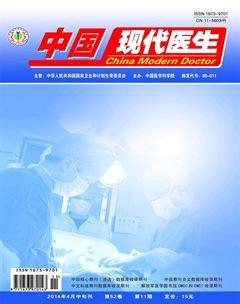不同类型肾小球疾病患者尿液中的蜡样管型分析
王中全 巩姣梅
[摘要] 目的 探讨不同类型的肾小球疾病患者尿液中的蜡样管型。方法 尿沉渣离心镜检、计数管型数量并分类。结果 300例肾小球疾病患者中,共发现蜡样管型42例(14.0%),其中急性感染后肾小球肾炎和肾淀粉样变管型比例最高,分别达到了45.5%和50.0%,局灶性节段性肾小球硬化和微小病变性肾病未检测到蜡样管型。 结论 不同类型肾小球疾病患者中蜡样管型的数量不同。
[关键词] 肾小球疾病;尿沉渣;蜡样管型
[中图分类号] R692.6 [文献标识码] B [文章编号] 1673-9701(2014)11-0146-03
[Abstract] Objective To investigate the waxy casts in the urinary sediment of patients with different types of glomerular diseases. Methods Urine sediment was centrifuged and read by microscopy. Then count the number of casts and classify them. Results About 42(14.0%) of 300 cases were found the waxy casts in patients with glomerular diseases. Acute glomerulonephritis and renal amyloidosis had the highest casts, 45.5% and 50.0% respectively. Moreover, waxy casts were not found in conditions such as focal and segmental glomerulosclerosis and minimal change nephropathy. Conclusion Waxy casts are different in various types of glomerular diseases.
[Key words] Glomerular diseases; Urinary sediment; Waxy casts
尿沉渣分析是尿液分析中重要的组成成分,对尿液干化学分析仪器诊断泌尿系统疾病具有重要的意义。管型(casts)为尿沉渣中有重要意义的成分,它的出现往往提示有肾实质性损害[1]。管型包括:透明管型、颗粒管型(细颗粒管型和粗颗粒管型)、脂肪管型、细胞管型(红细胞管型、白细胞管型、上皮细胞管型)、细菌管型、真菌管型、蜡样管型和混合管型[2]。对于透明管型、颗粒管型、脂肪管型、红细胞管型、白细胞管型、上皮细胞管型已经有很多的文献报道,而蜡样管型却鲜有报道,虽然其在19世纪后50年就已经被人类所认识[3]。本研究主要分析不同类型肾小球疾病患者尿液中的蜡样管型,以期为今后对蜡样管型的研究提供参考。
1 资料与方法
1.1一般资料
本研究收集了2010年1月~2013年6月来自郑州大学第二附属医院肾病科标本300例,年龄12~85岁,中位年龄48岁,其中男140例,女160例。除了尿沉渣镜检,还收集了每一个患者的尿pH值、比重和尿蛋白排泄量(g/L),同时记录了病程,时间从第一次化验结果表明肾功能障碍到肾活检。
1.2 纳入与排除标准
纳入标准:①肾活检诊断为肾小球疾病,且伴有中度到重度的管型尿;②尿沉渣检查在进行肾穿刺活检前几个小时进行。排除标准:尿路感染、白带污染、生殖器官出血、月经、肉眼血尿或肾穿刺活检的非典型性适应证(如未明确分类的肾小球疾病)。
1.3 尿沉渣检测
指导患者用肥皂和清水清洗外生殖器,弃去晨尿,2h后收集患者中段尿进行检测。标本处理:取10 mL尿液转移到尿沉渣离心管,400× g离心力下离心分离10 min,离心结束后,弃去9.8 mL上清液,将底部的沉淀物0.2 mL轻柔混匀,用移液枪吸取50 μL沉渣转移至载玻片上,覆盖24 mm×32 mm盖玻片,之后由几名专家双盲进行显微镜镜检。
对于每个样品的检测,首先在低倍镜下(10×10)对管型进行初步计数,评估患者是否可以纳入研究范围。然后,在高倍镜下(40×10),对每个样品计数100个管型,并进行分类。分类包括:透明管型、颗粒管型、蜡样管型、脂肪管型、红细胞管型、白细胞管型和上皮细胞管型等。对每个样品中的每种管型以计数100个管型中的含量进行报道。
蜡样管型的鉴别要点是:其形态折断或两端钝圆,缺口和锐利边缘,横向裂缝,高折射率和表面的外观让人想起融化的蜡。
1.4 统计学方法
采用SPSS 17.0 软件包进行统计学分析,分类变量间比较采用χ2检验。P<0.05为差异有统计学意义。
2 结果
2.1 患者一般资料分析
本研究300例患者中,男女患者分别为140例、160例,共发现蜡样管型42例(14.0%)。其中男22例,女20例,男女之间在有无蜡样管型上差异无统计学意义(P=0.423)。蛋白尿>0.15g/L的有284例(94.7%),其中有蜡样管型的患者尿蛋白含量高于无蜡样管型的患者。尿pH值范围介于5.0~8.0之间,见表1。
2.2不同类型的肾小球疾病中蜡样管型情况
在发现有蜡样管型的42例标本中,急性感染后肾小球肾炎和肾淀粉样变管型比例最高,达到了45.5%和50.0%。后面依次排列为过敏性紫癜肾小球肾炎(25.0%)、肾小球毛细血管性肾炎(25.0%)、坏死性肾小球肾炎(18.8%)、糖尿病肾病(16.7%)、IgA肾病(15.5%)、弥漫增生性肾小球肾炎(14.7%)、特发性膜性肾病(5.9%)。而在局灶性节段性肾小球硬化和微小病变性肾病中未检测到蜡样管型。经SPSS17.0总体统计分析所有的肾小球疾病显示,蜡样管型在不同类型肾小球疾病间存在统计学差异(χ2=37.388,P=0.000),见表2。endprint
3讨论
19世纪50年代科学家研究发现管型是尿沉渣的重要组成部分,其分类和现在的分类非常相似。蜡样管型之所以得名,是因为它的外观,易让人想起融化的蜡,而在肾脏疾病中蜡样管型的检出频率至今尚无文献报道。临床对蜡样管型的理解只停留在教课书上,本文结果证实了蜡样管型可能与广泛的肾脏疾病相关联,常见的有急性肾损伤(AKI)、快速进行性肾功能衰竭或慢性肾功能不全[4]。
据文献报道,临床给予呋喃苯胺酸治疗后可发现透明管型[5],在狼疮性肾炎复发患者中发现含有红细胞或白细胞的管型,从而使其成为狼疮性肾炎复发诊断的敏感指标[6]。有文献证实在IgA肾病患者中如果发现透明-颗粒管型,则预后不好,从而为狼疮性肾炎的预后增加了一项有效的指标[7]。也有报道称,系膜增生性肾小球肾炎颗粒管型的出现与血清肌酐,血清白蛋白的升高和蛋白尿显著相关,肾穿刺活检可见到一些病理改变,且这些指征的出现提示肾脏预后较差[8]。有学者报道在增生性肾小球疾病中可出现更高频率和数量的红细胞和肾小管上皮细胞管型[9],与之相比,在非增生性肾小球疾病中,脂肪管型更多一些[10]。Nakayama等[11]在2008年发现,在IgA肾病患者中,透明管型、颗粒管型、红细胞管型、白细胞管型和脂肪管型与肾穿刺活检的病理分级密切相关,其增多与肾脏预后较差有关。Chawla等[12]在2008年发现,与恢复后患者相比,急性肾损伤没有完全恢复的患者中可以检出更多的颗粒与肾小管上皮细胞管型。Perazella等[13]在2008年发现,颗粒管型和肾小管上皮管型计数可以区分急性肾损伤是否是由肾前性原因引起的急性肾小管坏死,其具有76%的灵敏度和86%特异性,阳性似然比为5.75。Fogazzi等[14]在2012年从21个急性间质性肾炎患者中检出6个(28.5%)含有红细胞的管型,远远高于以前的文献报道。有文献报道在广泛的肾脏疾病中都可以检出红细胞管型[15-17],其流行率为22%~55%。
本研究基于不同类型的肾小球疾病患者,专注研究其蜡样管型。结果显示,在局灶节段性肾小球硬化和微小病变性肾病中无蜡样管型,其在特发性膜性肾病中也很罕见。虽然无蜡样管型的这三种肾小球疾病的发病机制不同,但肾穿刺活检时均无炎性病变部位。本研究认为不同类型肾小球疾病患者中蜡样管型的数量不同。
[参考文献]
[1] Nishio S,Tsuboi N,Kurashige M,et al. A case of acute kidney injury during warfarin therapy[J]. Nihon Jinzo Gakkai Shi,2013,55(5):966-971.
[2] Buijsse B,Boeing H,Hirche F,et al. Plasma 25-hydroxyvitamin D and its genetic determinants in relation to incident type 2 diabetes:A prospective case-cohort study[J]. Eur J Epidemiol,2013,28(9):743-752.
[3] Gutierrez E,Egido J,Rubio-Navarro A,et al. Oxidative stress,macrophage infiltration and CD163 expression are determinants of long-term renal outcome in macrohematuria-induced acute kidney injury of IgA nephropathy[J]. Nephron Clin Pract,2012,121(1-2):c42-c53.
[4] Spinelli D,Consonni D,Garigali G,et al. Waxy casts in the urinary sediment of patients with different types of glomerular diseases:Results of a prospective study[J]. Clin Chim Acta,2013,424:47-52.
[5] Hao N,Xiong M,Zhang JD,et al. Portable thermo-powered high-throughput visual electrochemiluminescence sensor[J]. Anal Chem,2013,85(24):11715-11719.
[6] Dasgupta S,Eudaly J. Estrogen receptor-alpha mediates Toll-like receptor-2 agonist-induced monocyte chemoattractant protein-1 production in mesangial cells[J]. Results Immunol,2012,2:196-203.
[7] Shimizu A,Takei T,Moriyama T,et al. Clinical and pathological studies of IgA nephropathy presenting as a rapidly progressive form of glomerulonephritis[J]. Intern Med,2013, 52(22):2489-2494.
[8] Kanaji N,Kushida Y,Bandoh S,et al. Membranous glomerulonephritis associated with Mycobacterium shimoidei pulmonary infection[J]. Am J Case Rep,2013,14:543-547.endprint
[9] Grundmann F,Witthus M,Gobel H,et al. Monoclonal gammopathy-associated pauci-immune extracapillary-proliferative glomerulonephritis successfully treated with bortezomib[J]. Clin Kidney J,2013,6(3):327-329.
[10] Danilewicz M.,Wagrowska-Danilewicz M. The immunoexpression of glomerular NF-kappaB in proteinuric patients with proliferative and non-proliferative glomerulopathies[J]. Pol J Pathol,2013,64(2):78-83.
[11] Nakayama K,Ohsawa I,Maeda-Ohtani A,et al. Prediction of diagnosis of immunoglobulin A nephropathy prior to renal biopsy and correlation with urinary sediment findings and prognostic grading[J]. J Clin Lab Anal,2008, 22(2):114-118.
[12] Chawla LS,Dommu A,Berger A,et al. Urinary sediment cast scoring index for acute kidney injury:a pilot study[J]. Nephron Clin Pract,2008,110(3):c145-c150.
[13] Perazella MA,Coca SG,Kanbay M,et al. Diagnostic value of urine microscopy for differential diagnosis of acute kidney injury in hospitalized patients[J]. Clin J Am Soc Nephrol,2008,3(6):1615-1619.
[14] Fogazzi GB,Ferrari B,Garigali G,et al. Urinary sediment findings in acute interstitial nephritis[J]. Am J Kidney Dis,2012,60(2):330-332.
[15] Canale M. P,Rovella V,Staffolani E,et al. Nephrotic syndrome and abdominal arterial bruits in a young hypertensive patient:A case report[J]. Arch Ital Urol Androl,2012,84(4):238-241.
[16] Nakai K,Fujii H,Hara S,et al. Successful treatment of progressive renal injury due to granulomatous tubulointerstitial nephritis with uveitis[J]. Clin Exp Nephrol,2011, 15(5):765-768.
[17] D'Cruz S,Singh R,Mohan H,et al. Autosomal dominant polycystic kidney disease with diffuse proliferative glomerulonephritis-an unusual association:A case report and review of the literature[J]. J Med Case Rep,2010,4:125.
(收稿日期:2013-12-05)endprint
[9] Grundmann F,Witthus M,Gobel H,et al. Monoclonal gammopathy-associated pauci-immune extracapillary-proliferative glomerulonephritis successfully treated with bortezomib[J]. Clin Kidney J,2013,6(3):327-329.
[10] Danilewicz M.,Wagrowska-Danilewicz M. The immunoexpression of glomerular NF-kappaB in proteinuric patients with proliferative and non-proliferative glomerulopathies[J]. Pol J Pathol,2013,64(2):78-83.
[11] Nakayama K,Ohsawa I,Maeda-Ohtani A,et al. Prediction of diagnosis of immunoglobulin A nephropathy prior to renal biopsy and correlation with urinary sediment findings and prognostic grading[J]. J Clin Lab Anal,2008, 22(2):114-118.
[12] Chawla LS,Dommu A,Berger A,et al. Urinary sediment cast scoring index for acute kidney injury:a pilot study[J]. Nephron Clin Pract,2008,110(3):c145-c150.
[13] Perazella MA,Coca SG,Kanbay M,et al. Diagnostic value of urine microscopy for differential diagnosis of acute kidney injury in hospitalized patients[J]. Clin J Am Soc Nephrol,2008,3(6):1615-1619.
[14] Fogazzi GB,Ferrari B,Garigali G,et al. Urinary sediment findings in acute interstitial nephritis[J]. Am J Kidney Dis,2012,60(2):330-332.
[15] Canale M. P,Rovella V,Staffolani E,et al. Nephrotic syndrome and abdominal arterial bruits in a young hypertensive patient:A case report[J]. Arch Ital Urol Androl,2012,84(4):238-241.
[16] Nakai K,Fujii H,Hara S,et al. Successful treatment of progressive renal injury due to granulomatous tubulointerstitial nephritis with uveitis[J]. Clin Exp Nephrol,2011, 15(5):765-768.
[17] D'Cruz S,Singh R,Mohan H,et al. Autosomal dominant polycystic kidney disease with diffuse proliferative glomerulonephritis-an unusual association:A case report and review of the literature[J]. J Med Case Rep,2010,4:125.
(收稿日期:2013-12-05)endprint
[9] Grundmann F,Witthus M,Gobel H,et al. Monoclonal gammopathy-associated pauci-immune extracapillary-proliferative glomerulonephritis successfully treated with bortezomib[J]. Clin Kidney J,2013,6(3):327-329.
[10] Danilewicz M.,Wagrowska-Danilewicz M. The immunoexpression of glomerular NF-kappaB in proteinuric patients with proliferative and non-proliferative glomerulopathies[J]. Pol J Pathol,2013,64(2):78-83.
[11] Nakayama K,Ohsawa I,Maeda-Ohtani A,et al. Prediction of diagnosis of immunoglobulin A nephropathy prior to renal biopsy and correlation with urinary sediment findings and prognostic grading[J]. J Clin Lab Anal,2008, 22(2):114-118.
[12] Chawla LS,Dommu A,Berger A,et al. Urinary sediment cast scoring index for acute kidney injury:a pilot study[J]. Nephron Clin Pract,2008,110(3):c145-c150.
[13] Perazella MA,Coca SG,Kanbay M,et al. Diagnostic value of urine microscopy for differential diagnosis of acute kidney injury in hospitalized patients[J]. Clin J Am Soc Nephrol,2008,3(6):1615-1619.
[14] Fogazzi GB,Ferrari B,Garigali G,et al. Urinary sediment findings in acute interstitial nephritis[J]. Am J Kidney Dis,2012,60(2):330-332.
[15] Canale M. P,Rovella V,Staffolani E,et al. Nephrotic syndrome and abdominal arterial bruits in a young hypertensive patient:A case report[J]. Arch Ital Urol Androl,2012,84(4):238-241.
[16] Nakai K,Fujii H,Hara S,et al. Successful treatment of progressive renal injury due to granulomatous tubulointerstitial nephritis with uveitis[J]. Clin Exp Nephrol,2011, 15(5):765-768.
[17] D'Cruz S,Singh R,Mohan H,et al. Autosomal dominant polycystic kidney disease with diffuse proliferative glomerulonephritis-an unusual association:A case report and review of the literature[J]. J Med Case Rep,2010,4:125.
(收稿日期:2013-12-05)endprint

